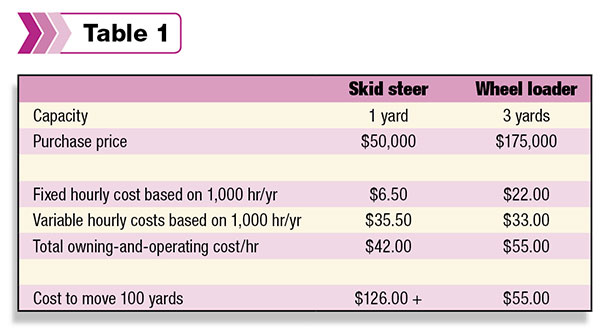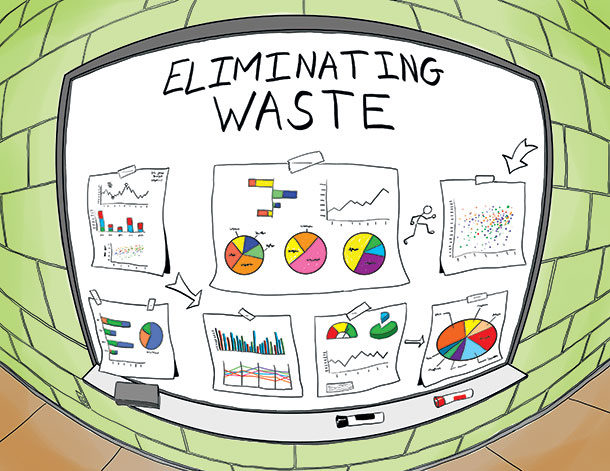Ray Kroc, the founder of McDonald’s, said: “McDonald’s is not in the hamburger business but the real estate business.” There have been several books written on Mr. Kroc’s life and the founding and establishing of McDonald’s I find fascinating.
The most intriguing fact to me is that inside McDonald’s they knew what they were really doing was using burgers to amass the largest collection of prime real estate available.
I understand that the farm is a diverse business of agronomy and husbandry often at the mercy of the environment and economy, but these challenges are not unique to agriculture. Businesses are a compilation of their processes. The processes that take up your time and resources define the kind of business you are.
On the farm it seems obvious that we know what kind of business we are in, but when I ask, “What type of business is this?” about farms I consult with, I come to the conclusion time and time again that, “This is a material-handling business.”
Material-handling businesses spend a majority of their labor, equipment and fuel expenses on moving material from one spot to another. Does that sound a little more like a farm? Then let’s look at moving material as your core business and with a special scrutiny farmers can learn from.
Material-handling businesses understand owning and operating costs (O&O). Equipment purchase decisions are too often based on the selling price of a piece of equipment when more than half of the cost of owning and operating a machine comes from variable costs such as fuel, tires, real labor and maintenance.
Using this information more accurately helps analyze purchasing, operating and billing decisions. There are several spreadsheets available to help you calculate the O&O of a piece of equipment.
To better understand O&O, use the example of a 1-yard-capacity skid steer versus a 3-yard wheel loader ( Table 1 ). The loader sell price is more than three times that of a skid steer, but because of the variable costs, there is far less discrepancy between the hourly skid steer O&O, which is near $42, and a loader at $55.

If moving 100 yards of material with a loader costs $55, it could conceivably cost $120 or more with the skid steer with its smaller capacity. Additionally, we need to look at the other variables, such as the capability requirements of the machine and the volume of the work to be done in order to make an informed decision.
Is there any reason to measure what you will not manage?
Material-handling businesses measure with a purpose and use metrics as part of their management scheme. In this data-intense world, a company can be flooded with measurements, but measuring does nothing without a clear intent to do something with the data.
That is where metrics come in. A metric applies a baseline and goal to a measurement and gives us a direction. Metrics are clear, aligned throughout the company and visible.
Examples of metrics
High-level
Equity-to-asset ratio
ROI
Mid-level
Wages per ton of silage
Labor equivalents
Ground-level
Average days in milk
Calf mortality 0-60 days
As an example of the difference between measurement and metrics, let’s look at a dairy farm. It is easy to measure how much milk is shipped from the farm each day, but that simple measure tells us nothing about the profitability of the farm.
Taking it to the next level, farms use this number and herd size to uncover production per cow; this is still relatively meaningless when it comes to business performance. However, a metric such as feed expense per hundredweight or labor cost per hundredweight could be very helpful to giving you a direction in production and studying the impact of changes.
Metrics can be used throughout a company and are specific to the group using them. An owner might be looking at metrics that are different from the manager or the person feeding calves, but all metrics should be aligned to reach the same goals.
An owner may be looking at return on investment, the manager may be looking at full-time employee equivalents, and the breeder may be looking at days open. However, all of these metrics feed into profitability and are appropriate to the level of control of the position using them.
Dashboards are a way to display metrics that give visibility of performance relevant to an area. These can be as simple as copypaper thumb-tacked to a wall or as sophisticated as a computer monitor dedicated to the display. The important thing is the metrics need to be on display and clear to the people using them. A 30-second view of a dashboard should quickly tell anyone if a department is meeting its goals.
Good managers realize there are parts of the business that cannot be measured, such as dealing with the dynamics of human elements of their business. Metrics can help alleviate some of those dynamics by clarifying the expectations and responsibilities of employees.
Eli Goldratt, author of The Goal , said “Tell me how you will measure me, and I will tell you how I will act.” Metrics give clear direction to the entire company as to where it is headed. When employees have a direction, it gives their job purpose and allows them to make decisions aligned with the owners.
On the farm, some of the metrics seem more complicated than tons per hour or trucks per day, and other metrics used in material-handling businesses, but once measurements are put in place and a collection method developed, they are a powerful tool to improve businesses.
Don’t get stuck in the ‘muda’
In the Japanese language the word “muda” means waste, uselessness and futility. Material-handling businesses strive to eliminate waste from their process by using lean principles. These principles have a storied beginning but came to the mainstream with the Toyota Production System (TPS) as it was developed from 1948-1975.
In the 1970s, companies around the world started to adapt the TPS principles into what is now known generically as lean manufacturing. In recent years, many farms have begun to adopt these concepts as they can be applied to “lean farming.” All too often, we chase profits simply by striving to reduce costs, but waste is a cost as well and can often be controlled quickly with a small amount of resources applied to it.
There are nine types of waste (muda) that can be targeted to increase profits.
1. Transport . The waste of moving materials between locations
2. Inventory . The waste of resources tied up in raw materials and finished products
3. Motion . The waste of unnecessary movement
4. Waiting . The waste of waiting for a machine, process, product to arrive, etc.
5. Overproduction . The waste of producing more than can be sold at projected profits
6. Overprocessing . The waste of adding steps to produce a product not required by the customer
7. Defects . The waste of mistakes in the process and necessary rework
8. Talent . The waste of not using the talents of your employees to the fullest
9. Resources . The waste of not turning off lights, machines, etc.
Muda is often difficult to identify without practice since you are most likely used to the daily activities around you. A good starting point for me is to understand costs associated with waste and review them often to keep them relevant.
What is the owning and operating cost of the tractor idling in the driveway (resources)? What could be gained if I let a capable employee take on new responsibilities (talent)?
What is the cost of a mastitis case caused by improper parlor procedures or systems (defect)? When you know the costs of waste, it is much less likely you will ignore it. Additionally, modify your schedule and alternate your routines to give yourself fresh eyes to the wastes.
Two other types of waste often contribute to the muda. First is “mura,” which means inconsistency, inequality, non-uniformity; it is the lack of flow and the absence of processes. In the agriculture world, this is not as easy to see as it is in many material-handling businesses, but the waste still exists.
Think about the day when everything goes right, no breakdowns or surprises to deal with, and how much you got accomplished. You can experience more of these days with preventative maintenance systems and standardized work for employees. Getting in front of breakdowns gives us the ability to plan repair costs. Standardized work relieves managers from daily employee scheduling.
Finally, “muri” is the waste of overburden, it means unreasonable in Japanese. This is the waste of stress on people and machines; neither performs well when expected to do more than they are capable of.
Muri can be eliminated by clear processes like you might in using a written milking procedure: training, metrics and known expectations. Dealing with muri leads to higher employee morale and retention. It improves quality and reduces costs.
Determining that your farm is a material-handling business will open your eyes to important costs impacting your dairy business as you watch for the wasteful activities associated with moving your dairy’s materials. Eliminating them will lead to increased profitability for your dairy. PD
Allen Bonthuis is a sales consultant with AIS Construction Equipment. He can be contacted by email .
Illustration by Fredric Ridenour.
What kind of businessis a mine?
The mining of commodities leading to the separation, cleaning, storage, transport, and eventual addition to a value-added product by the mine or other processing company.
What kind of businessis a farm?
The harvest of commodities leading to the separation, cleaning, storage, transport, and eventual addition to a value-added product by the farm or other processing company.







